#1-test cap recipe
Explore tagged Tumblr posts
Text
Today I bring you a short and sweet caps bath and a little tutorial on how i clean them from dirt and soil since I mostly collect them from the ground.

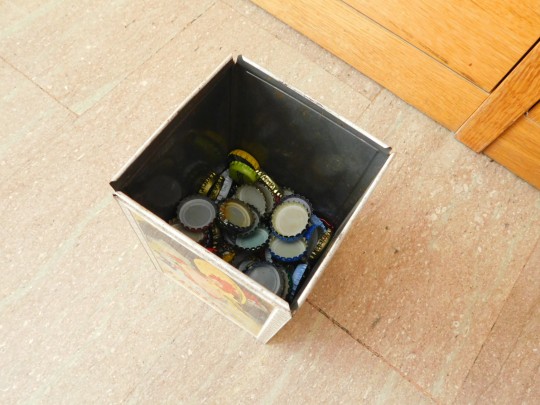
This is Lidia, she is a old box of candy that my grandfather used for storing nails, but now she greedily feeds off of caps.
For this recipe you will need:
A container with a little water
A toothbrush with soft bristles
Dish soap
One (1) towel to use like "landing pad"
One (1) smaller towel to dry off the caps
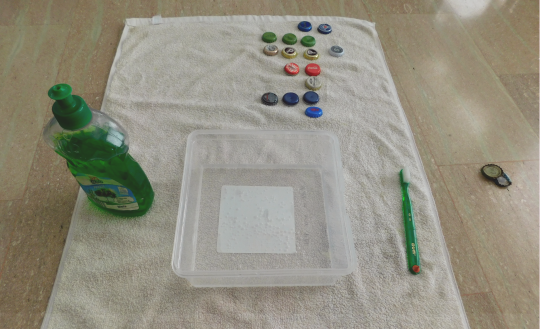
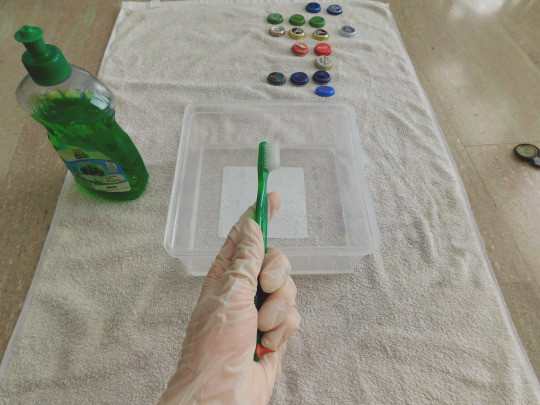
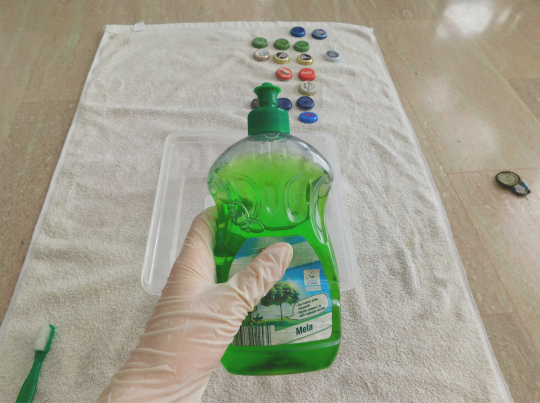
The process is quite easy, you put the dish soap in the water and you can use the toothbrush to scrub away the dirt.
And then the pool party begins.

You can leave the little fellas to soak for a while, after that I usually place them on the landing pad towel I wait for them to dry off a bit, then I use the smaller towel to remove the excess water.
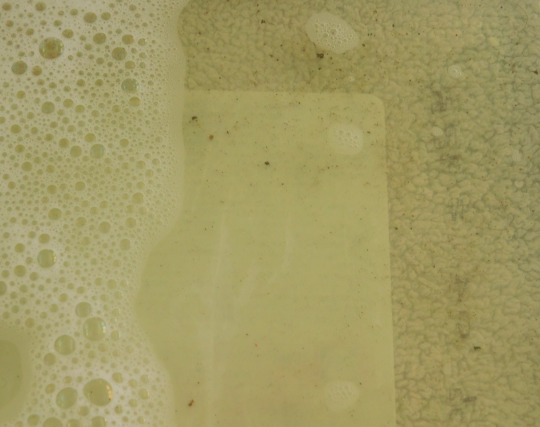
Dirty water.
If you aren't sure if your caps are 100% dry I advice to let them have a jolly sun bath.
And here they are, your now shining treasures! :)
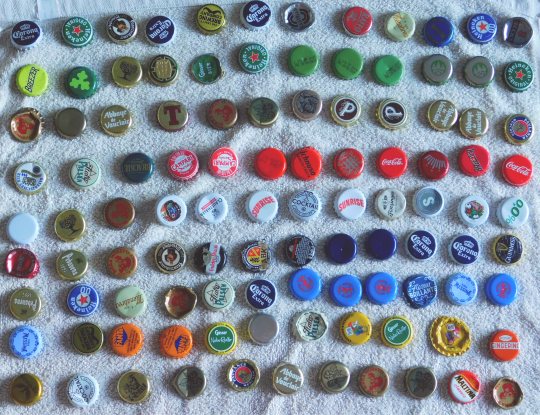
Note: this works best with NOT rusty caps, I am now testing a way to remove rust, my roommate recommended to use vinegar so stay tuned for tomorrow to know if it worked :)

#goblincore#treasure#caps#metal caps#tutorial#cleaning#shiny#photography#collection#goblin collection
2 notes
·
View notes
Photo



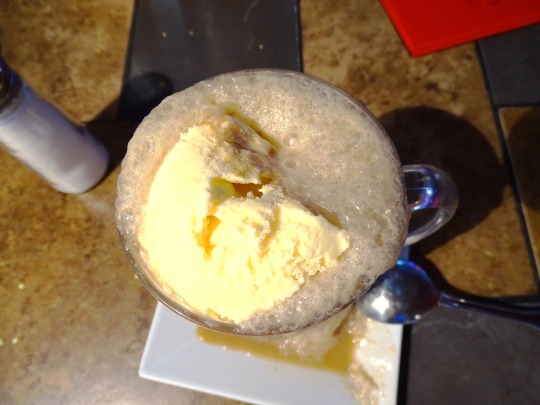


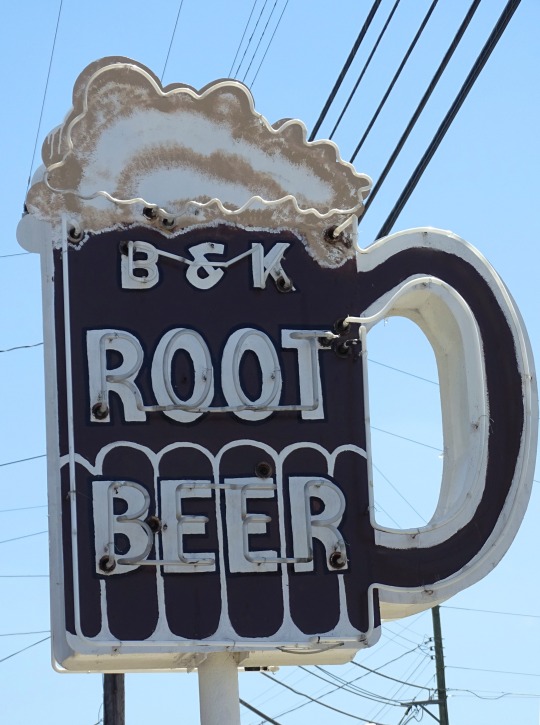



National Root Beer Float Day
Diet? Not on August 6. It’s National Root Beer Float Day, after all — a time to enjoy one of the best beverage/dessert combos on the planet. On that day, some even compete for root beer float greatness. It all started in Colorado back in 1893. Frank J. Wisner was inspired. Surrounded by Cow Mountain where his Cripple Creek Brewing Company was located, Wisner came up with a novel idea. While mountain gazing, he didn’t see snow-covered peaks. Instead, Wisner envisioned scoops of ice cream floating in root beer. Crazy, right? So, today, enjoy the tallest, fizziest root beer float you can find!
Note: Read on to find out how you can get a free A&W root beer today!
When is National Root Beer Float Day 2022?
The frothy beverage/dessert combo we all love is celebrated on National Root Beer Float Day on August 6.
History of National Root Beer Float Day
The unique fusion of ice cream with root beer is unlike anything else. This summertime delicacy has a history as rich as its texture and flavor!
Frank J. Wisner, the owner of Colorado’s Cripple Creek Brewing, is the person to thank for creating the root beer float on August 19, 1893. The idea behind this extraordinary innovation came to Wisner when he was looking at the snowy peaks of Colorado’s Cow Mountain that gave the illusion of ice cream floating on a beverage. While staring out of the window of the Cripple Creek Cow Mountain Gold Mining Company, Wisner thought the glow of the full moon made the snow-capped mountains resemble ice cream.
The following day, Wisner got to work combining vanilla ice cream with root beer and calling the result the ‘Black Cow Mountain.’ The soda he had used was Myers Avenue Red Root Beer. The root beer float was served to his guests the very next day and became an instant hit. Children shortened the word to ‘Black Cow,’ and today it is simply known as root beer float.
National Root Beer Float Day timeline
1876 A pharmacist sells root beer commercially
Pharmacist Charles Elmer Hires debuts a commercial version of root beer at the Philadelphia Centennial Exposition.
1919 A&W has humble beginnings at a root beer stand
Ray Allen opens a root beer stand in Lodi, California, which would eventually become the A&W restaurant chain.
The 1920s Root beer turns into a fad
The popularity of non-alcoholic root beer explodes during Prohibition.
1960 The FDA bans a key root beer ingredient
The FDA bans safrole, the aromatic oil that initially gave root beer its distinctive flavor. The ingredient caused liver damage during animal testing.
Traditions
Since its creation, countless root beer floats have been enjoyed throughout the world. The tradition of the day is to enjoy refreshing root beer floats. The original recipe has evolved into many variations, each with their own unique flavor, while retaining the original root beer float texture.
Popular root beer floats that have become traditional favorites include the Coke Float, Boston Cooler, Purple Cow, and the Harry Potter-inspired Butterbeer.
National Root Beer Float Day By The Numbers
1876 – the year when root beer was invented 16 – the number of roots and herbs that root beer is made of. 3% – the percentage that root beer makes up in America’s soft drink market. 1960 – the year when a key ingredient of root beer, the sassafras root, was banned by the FDA. #1 – the ranking of A&W as the leading root beer brand in America.
National Root Beer Float Day Activities
Whip up your own root beer float
Conduct some root beer research
Throw a root beer party for adults
There's no better way to celebrate National Root Beer Float Day than by concocting your own root beer float. Grab a bottle of your favorite brand of root beer, pour into a chilled glass and top off with a fresh scoop of vanilla ice cream. Nice!
Now, this is the kind of research you can appreciate! The Root Beer Store sells more than 100 brands and flavors of root beer. You can check out customer reviews of all the root beers for sale and even order mix-and-match bottles. Your local specialty liquor store may also have a pretty good selection, so drink up!
Hard root beer is blowing up! Clever brewers have come up with root beers that include varying levels of alcohol. Invite the neighbors over for a dessert party and imbibe on some root beer floats. But be careful, while the root beer goes down fast and smooth, it'll eventually catch up with you.
5 Reasons We Need A Root Beer Float, Like Right Now
Root root
The Philly float
The custard float is a definite thing
Why float when you can freeze?
The root beer float with a kick
Jeni's ice cream shops can double your pleasure with root beer floats made with root beer ice cream and Boylan root beer.
The Franklin Fountain in Philadelphia creates authentic root beer floats made with their own brand of root beer syrup and ice cream.
Scooter's Frozen Custard in Chicago offers a root beer float made with vanilla custard, a refreshing twist on the standard float.
Instead of floating the ice cream on top of a glass of root beer, blend the two together to make a root beer freeze.
SpringHouse restaurant in Alexander City, Alabama, serves up a bourbon float made with Buffalo Trace bourbon, bourbon ice cream and a house-made root beer syrup.
Why We Love National Root Beer Float Day
It's a perfect combination
Floats come in many varieties
It generates donations for a good charity
It seems like such a simple recipe — root beer in a tall, iced glass and two scoops of vanilla ice cream. But if you're trying to get beyond the ordinary, then use extraordinary ingredients. Select a frothy root beer with a high sarsparilla content and loads of sweetness. Add rich, vanilla bean ice cream and get creative with your toppings.
The Boston Cooler was invented in Detroit, of all places, and is made with Vernor's ginger ale and vanilla ice cream. In many Asian eateries you can order a Snow White, which is composed of vanilla ice cream and 7-Up or Sprite. In Mexico, you can grab a Holado flotante, a combination of cola and lemon sherbet.
On National Root Beer Float Day, A&W Restaurants collects donations for Disabled American Veterans, a charity that fights for better health care benefits for America's injured heroes. What a sweet idea!
Source
#Black Cow#I love root beer float#Root Beer Float#ice cream#Van Wert#restaurant#Colorado#2022#Ohio#B & K Root Beer Stand#drive in#USA#summer 2019#original photography#tourist attraction#landmark#travel#street scene#cityscape#National Root Beer Float Day#7 August#vacation#neon sign#rental car#fries
4 notes
·
View notes
Text
What Retailers Need from a Fruit Crush OEM Partner
Retailers today are increasingly launching in-house brands across various food and beverage categories. Among these, fruit crushes are becoming a staple due to their versatility, shelf appeal, and high consumption. However, the success of a private label fruit crush line depends heavily on choosing the right OEM partner.
In this guide, we’ll outline what retailers need from a fruit crush OEM partner and why RFP Private Label Manufacturer—also a leading Private Label Fruit Jam Manufacturer and Private Label Mocktail Syrup Manufacturer—is the right choice for retailers looking to scale their private label beverage segment.

What Is an OEM Partner in the Fruit Crush Segment?
An OEM (Original Equipment Manufacturer) partner produces goods based on standard or customizable recipes under the retailer’s brand. In the case of fruit crushes, OEM partners handle:
Ingredient sourcing
Manufacturing and bottling
Labeling and branding support
Packaging and delivery
This model enables retailers to focus on branding, marketing, and sales while leaving production to specialists.
Why Fruit Crush Is a High-Demand Category
Used in multiple ways: Milkshakes, ice cream toppings, mocktails, desserts
Broad demographic appeal: Loved by kids, teens, and adults
Year-round sales: Especially popular in warm climates and festive seasons
High shelf turnover: Attractive margins and fast-moving inventory
Retailers can tap into these benefits with a reliable OEM manufacturing partner.
What Retailers Should Expect from a Fruit Crush OEM Partner
1. Scalable Manufacturing
Ability to handle both low MOQs and high-volume orders
Consistent batch quality and taste across scales
2. Product Quality
Use of real fruit pulp
Balanced flavor, color, and sweetness
Free from artificial additives (or with clean-label alternatives)
3. Wide Flavor Range
Classics: Mango, Strawberry, Mixed Fruit
Exotics: Lychee, Guava, Pineapple
Custom seasonal blends available
4. Certifications and Compliance
FSSAI, ISO 22000, HACCP compliance
Batch testing and shelf-life validation
Export documentation (COA, MSDS, etc.)
5. Flexible Packaging
PET bottles: 200ml, 500ml, 1L
Glass bottles (premium segment)
Bulk drums for Horeca and institutional use
Why RFP FMCG Is a Preferred OEM Partner for Retailers
As a top-rated Private Label Fruit Crush Manufacturer, RFP FMCG offers unmatched reliability, scale, and product quality.
Core Strengths:
Over 10 years of OEM experience
In-house R&D and flavor innovation
Customized branding solutions
Low MOQ support for pilot runs
High-capacity infrastructure for national retail chains
RFP's Fruit Crush Manufacturing Capabilities
Available Flavors:
Mango Crush
Strawberry Crush
Mixed Fruit Crush
Guava Crush
Lychee Crush
Blueberry and Pineapple (seasonal)
Format Options:
Retail bottles
Horeca packs
Export-ready bottles with multilingual labels
Customization Services for Retailers
Flavor Tweaks: Adjust sugar levels, add natural colors, or infuse botanicals
Label Design: Retail branding, barcodes, QR codes, and compliance
Packaging Types: Custom bottle shapes and cap designs
Seasonal Bundles: Diwali, Ramadan, and summer-themed assortments
Complementary Product Expansion
Retailers can cross-sell with related products from RFP FMCG:
Private Label Fruit Jam Manufacturer
Mixed Fruit, Mango, Strawberry, and more
Glass jars and PET options
Sugar-free and gourmet variants
Private Label Mocktail Syrup Manufacturer
Flavors: Mojito, Rose, Green Apple
Ideal for Horeca and summer beverage promotions
Bundling crushes, jams, and syrups allows better shelf visibility and festive promotions.
Retailer Success Stories with RFP FMCG
National Retail Chain in India
Sourced five fruit crush SKUs from RFP with full branding. Sales increased by 27% during the summer quarter.
Supermarket Brand in the Middle East
Launched Arabic-labeled mango and lychee crush. Became the No.1 beverage item in select stores within two months.
D2C Brand in Wellness Category
Opted for sugar-free fruit crush variants. RFP helped them design minimalistic labels and eco-friendly packaging.
Retail Distribution Support from RFP
Timely production and restocking for chain-wide rollout
Logistics coordination for national and export dispatch
Batch tracking for traceability and reordering
Seasonal demand planning and promotional stock supply
How to Onboard RFP as Your OEM Partner
Initial Consultation Discuss product vision, flavor choices, and packaging preferences.
Sampling Receive samples of crushes for feedback and refinement.
Label Finalization Customize design and verify compliance.
Pilot Order Test-market in selected stores with 500–1000 unit batches.
Full Rollout Place larger orders based on performance with assured quality and consistency.
Conclusion
Retailers entering the private label fruit crush segment need a dependable, quality-driven OEM partner who understands their scale, brand, and timeline. With expert formulation, scalable production, and retail-savvy support, RFP Private Label Manufacturer delivers on all fronts.
As a proven Private Label Fruit Crush Manufacturer, Private Label Fruit Jam Manufacturer, and Private Label Mocktail Syrup Manufacturer, RFP FMCG empowers retailers to launch, grow, and lead in the highly competitive beverage market.
FAQs
1. What is the MOQ for OEM fruit crush production at RFP? Typically starts from 500 bottles per SKU.
2. Can I customize the flavor profile? Yes. RFP supports full flavor and sweetness customization.
3. Do you support retail packaging and labeling? Absolutely. RFP offers design, compliance, and packaging under your brand.
4. Is export documentation provided? Yes. RFP provides all necessary export certifications and labeling.
5. Can I bundle fruit crush with jams and syrups? Yes. RFP enables cross-category production and bundled private label offerings.
0 notes
Text
How to Leverage Contract Jam Production Services
If you’re planning to launch or expand your own jam brand, working with a contract jam production service is one of the smartest strategies. This model allows you to tap into expert manufacturing capabilities while focusing on branding, distribution, and customer engagement.
In this guide, we’ll explore how contract production works and how RFP Private Label Manufacturer—a leading Private Label Fruit Jam Manufacturer, Private Label Fruit Crush Manufacturer, and Private Label Mocktail Syrup Manufacturer—helps brands succeed with scalable, compliant, and custom manufacturing.

What Is Contract Jam Production?
Contract production refers to outsourcing the manufacturing of jams to a third-party provider under agreed specifications. As a brand owner, you retain control over branding and marketing, while your contract manufacturing partner handles:
Ingredient sourcing
Recipe development
Cooking and bottling
Labeling and compliance
Packaging and logistics
This model reduces your overhead and accelerates product launch.
Advantages of Contract Jam Production
1. Low Startup Investment
No need for a manufacturing facility, licenses, or full production staff. You pay only for what you produce.
2. Faster Time to Market
With an experienced contract partner, your jam line can launch in just 4–6 weeks.
3. Access to Food Safety and Compliance Expertise
Certified partners ensure:
FSSAI compliance
ISO 22000 and HACCP certifications
Export labeling and documentation
4. Scalable Production
Start small and scale up as demand grows—without increasing operational stress.
5. Customization Options
You can create:
Unique flavors
Organic and sugar-free variants
Personalized labels and packaging
Why Choose RFP FMCG as Your Contract Manufacturer
RFP Private Label Manufacturer is one of India’s leading names in private label and contract food manufacturing. With a focus on jams, fruit crushes, and mocktail syrups, RFP offers full-stack manufacturing support.
Key Credentials:
Over 10 years in private label production
Global client base across GCC, EU, Africa, and North America
State-of-the-art R&D, processing, and bottling infrastructure
RFP’s Jam Production Capabilities
RFP FMCG produces a wide variety of jams and fruit preserves, including:
Mixed Fruit Jam
Mango Jam
Strawberry Jam
Pineapple Jam
Guava Jam
Exotic blends (Kiwi, Blueberry, Passion Fruit)
These are available in:
Glass jars (100g, 200g, 500g, 1kg)
PET jars
Bulk packaging for Horeca
Customization Options
RFP supports:
Flavor tweaking (natural, low sugar, sugar-free)
Texture options (chunky, smooth)
Fortified jam variants (vitamin-enhanced)
Clean label ingredients
Multilingual labeling
How to Get Started with RFP’s Contract Jam Production
Step 1: Product Planning
Outline your brand’s vision:
Target audience (gourmet, mass-market, wellness)
Flavor selection
Volume expectations
Retail or export focus
Step 2: Consultation
Connect with RFP FMCG’s team to:
Understand lead times and costs
Discuss regulatory needs
Choose ingredients and packaging
Step 3: R&D and Sampling
Receive 2–3 samples based on your brief
Provide feedback on taste, consistency, and appearance
Step 4: Packaging and Branding
Choose jar types, cap colors, and label materials
RFP offers in-house design for labels and print-ready packaging
Step 5: Trial Batch Production
Conduct a pilot batch for test markets or sampling
Step 6: Bulk Production and Delivery
Finalize volume
Choose domestic or export dispatch
Expansion Opportunities Beyond Jam
Once your jam brand is launched, you can easily expand into other product categories with the same trusted partner.
RFP as a Private Label Fruit Crush Manufacturer
Mango, Lychee, Guava, Strawberry, and more
Used in shakes, desserts, and beverages
RFP as a Private Label Mocktail Syrup Manufacturer
Flavors like Mojito, Green Apple, Blue Curacao
Ideal for cafes, restaurants, and home use
Combining product lines enhances brand visibility and increases revenue potential.
Real-World Success Stories
Gourmet Jam Startup
A health-focused D2C brand created an organic jam line with RFP’s clean-label options. The brand saw a 40% reorder rate within three months.
Retail Chain Jam Line
A national retailer used RFP to launch its in-house jam label. With timely manufacturing and eye-catching packaging, the jams became a top-seller within 90 days.
Exporter to GCC
An Indian exporter partnered with RFP to develop Arabic-labeled jam jars. The range quickly gained popularity in hypermarkets across UAE and Qatar.
Key Considerations Before Choosing a Contract Manufacturer
Do they have certifications like FSSAI, ISO, HACCP?
Are MOQs startup-friendly?
Can they customize recipes?
Is export documentation supported?
Do they assist with branding and packaging?
RFP FMCG checks all these boxes and more.
Conclusion
Contract jam production is a powerful way to build a food brand without getting bogged down by operations. With the right manufacturing partner, you can scale from concept to shelf in a matter of weeks.
RFP Private Label Manufacturer makes it simple to bring your jam ideas to life. As a certified Private Label Fruit Jam Manufacturer, Private Label Fruit Crush Manufacturer, and Private Label Mocktail Syrup Manufacturer, RFP offers reliability, innovation, and scalability—everything you need to succeed in the competitive food space.
FAQs
1. What is the minimum order quantity with RFP? Typically starts from 500–1000 units depending on the format and flavor.
2. Can I create my own jam recipe? Yes. RFP supports full recipe customization with in-house R&D.
3. How long does production take? Standard turnaround is 4–6 weeks from sample approval.
4. Does RFP offer label design? Yes. Their creative team provides label design and compliance guidance.
5. Can I bundle jams with crush and syrup? Absolutely. RFP supports multi-product private label solutions.
0 notes
Text
High-Quality Fruit Crush for Retailers: How to Source It
Retailers looking to expand their beverage or grocery lines are increasingly turning to fruit crush as a staple offering. These versatile, fruity concentrates are perfect for making milkshakes, mocktails, and dessert toppings. But the challenge lies in sourcing high-quality fruit crush that delivers on taste, consistency, shelf-life, and branding flexibility.
In this blog, we explore what to look for when sourcing fruit crush for your retail brand and why RFP Private Label Manufacturer, a top-tier Private Label Fruit Crush Manufacturer, Private Label Fruit Jam Manufacturer, and Private Label Mocktail Syrup Manufacturer, is the right partner for delivering high-quality, market-ready products.

What Is Fruit Crush?
Fruit crush is a semi-liquid concentrate made using real fruit pulp, sugar, and food-grade additives. It is typically used for:
Milkshakes and smoothies
Mocktails and cocktails
Dessert toppings
Fruit sodas and slushes
The appeal for retailers lies in its year-round demand, vibrant flavors, and high margin potential.
Why Retailers Need Quality Fruit Crush Suppliers
Poor-quality fruit crush can lead to:
Unpleasant taste or aftertaste
Inconsistent texture or thickness
Sedimentation or separation
Low shelf stability
Bad consumer reviews and returns
Choosing the right supplier ensures customer satisfaction, brand loyalty, and regulatory compliance.
What Makes a Fruit Crush High-Quality?
1. Real Fruit Content
Must contain real fruit pulp, not just artificial flavors.
Should taste natural and authentic.
2. Consistent Texture
Smooth and pourable
No lumps or watery separation
3. Shelf Life and Preservation
Minimum 6–12 months shelf life
Minimal preservatives with high pasteurization standards
4. Clean Label Ingredients
No harmful chemicals
FSSAI-approved ingredients
5. Packaging Quality
Leak-proof and tamper-evident
Eye-catching design suitable for retail shelves
Key Sourcing Channels for Retailers
Retailers typically have three options to source fruit crush:
1. National FMCG Brands
Pros: Established reputation, ready inventory
Cons: High cost, little customization
2. Import from Global Suppliers
Pros: Unique flavors, international branding
Cons: Import duties, long lead times
3. Partner with a Private Label Manufacturer
Pros: Full branding control, custom recipes, better margins
Cons: Requires involvement in branding and approvals
RFP Private Label Manufacturer excels in option 3—custom fruit crush for your brand with flexible MOQs and full support.
Why RFP FMCG Is the Ideal Fruit Crush Partner for Retailers
As a reliable Private Label Fruit Crush Manufacturer, RFP offers:
ISO 22000, HACCP, FSSAI certifications
Low MOQs for test markets
Premium ingredients and clean processing
In-house label design and compliance support
Export-ready logistics and documentation
Whether you're selling in supermarkets, specialty stores, or online platforms, RFP has solutions for every channel.
Flavors Offered by RFP FMCG
RFP's fruit crush range includes:
Mango Crush
Mixed Fruit Crush
Strawberry Crush
Guava Crush
Lychee Crush
Seasonal and exotic flavors
Retailers can pick standard flavors or co-develop unique variants with RFP’s R&D team.
Packaging Options for Retailers
RFP FMCG provides:
PET Bottles: 200ml, 500ml, 1L
Glass Bottles (on request)
Custom caps and closures
Shrink sleeves, printed labels, and multilingual options
Retailers can opt for bulk supply for in-house bottling or shelf-ready branded products.
Cross-Sell Opportunities with RFP FMCG
RFP isn’t just a Private Label Fruit Crush Manufacturer. They also offer:
Private Label Fruit Jam Manufacturing
Mixed Fruit, Mango, Strawberry, and more
Organic and sugar-free variants
Jars and pouches with custom branding
Private Label Mocktail Syrup Manufacturing
Mojito, Blue Curacao, Green Apple, Rose
Horeca, retail, and export packs
Custom recipes and festive editions
This enables retailers to launch fruit-themed lines and bundled gift packs.
The Sourcing Process with RFP FMCG
Consultation: Define your brand needs, flavor preferences, and packaging vision.
Sample Development: Receive and test flavor samples.
Packaging Customization: Choose label design, bottle shape, and language support.
Trial Batch Production: Conduct market testing with pilot batches.
Bulk Fulfillment: Receive retail-ready products or bulk concentrates.
Logistics and Export: RFP supports national and global shipping.
Retailer Success Stories
Case 1: Supermarket Brand Launch
A North Indian retail chain partnered with RFP to develop a private label fruit crush range. Within 3 months, they launched mango and lychee variants under their own brand—resulting in a 22% lift in beverage category sales.
Case 2: Online Gourmet Store
An e-commerce brand introduced sugar-free mixed fruit crush through RFP. The product gained rapid traction among diabetic and wellness-conscious consumers.
Case 3: Global Distributor
A Middle East-based distributor sourced RFP's mango and strawberry crushes, relabeled in Arabic, and launched across 4 countries with export support from RFP.
Conclusion
Retailers looking to grow in the beverage category need reliable, high-quality fruit crush offerings that meet consumer taste and branding expectations. Partnering with an experienced manufacturer ensures you avoid common pitfalls while maximizing market opportunity.
RFP Private Label Manufacturer is your trusted partner for sourcing premium fruit crush products. As a certified Private Label Fruit Crush Manufacturer, Private Label Fruit Jam Manufacturer, and Private Label Mocktail Syrup Manufacturer, RFP delivers innovation, flexibility, and scale—perfect for modern retail needs.
FAQs
1. What is the MOQ for RFP's fruit crush production? Typically starts from 500 to 1000 units depending on the SKU.
2. Can I customize flavors and packaging? Yes. RFP supports custom recipes, labels, and bottle formats.
3. Does RFP offer support for international orders? Absolutely. RFP provides documentation and labeling for global markets.
4. Are sugar-free or organic variants available? Yes. RFP offers sugar-free, low-sugar, and organic options.
5. Can I bundle fruit crush with jams and syrups? Yes. RFP enables bundling across all fruit-based product lines.
0 notes
Text
The Process Behind Fruit Crush Bottling Services
Fruit crush is a vibrant, high-demand product across global markets. But while flavor and packaging matter, the process of fruit crush bottling services is what ensures consistency, safety, and scalability. For private label brands, understanding this process is key to selecting the right manufacturing partner.
In this blog, we’ll break down the step-by-step fruit crush bottling process and explain how RFP Private Label Manufacturer, a leading Private Label Fruit Crush Manufacturer, Private Label Fruit Jam Manufacturer, and Private Label Mocktail Syrup Manufacturer, offers full-spectrum bottling and private label services.

Why Bottling Matters in Fruit Crush Production
Bottling is more than just filling a container. It’s about:
Preserving freshness and flavor
Ensuring product safety
Extending shelf life
Creating shelf appeal with packaging
Facilitating distribution and export
A reliable bottling service balances aesthetics with functionality and compliance.
Step-by-Step: How Fruit Crush Bottling Works at RFP FMCG
1. Fruit Sourcing and Pulp Preparation
Fresh fruits are procured from certified farms.
Fruits are washed, peeled, and pulped.
The pulp is filtered and checked for purity.
2. Recipe Formulation
Ingredients like fruit pulp, sugar, citric acid, and natural flavors are measured.
RFP’s R&D team develops standard or custom flavor blends.
3. Pasteurization
The mix is pasteurized to eliminate microbial activity.
This ensures product safety and longer shelf life.
4. Bottling and Filling
Heated crush is filled into pre-sterilized bottles.
Types of bottles: PET, glass, or foodservice pouches.
Volumes: 200ml, 500ml, 1L, 5L, and more.
5. Capping and Sealing
Bottles are immediately capped using tamper-evident closures.
Vacuum sealing is applied where necessary.
6. Labeling and Branding
Custom labels are applied with branding, nutritional info, and barcodes.
Multilingual and export-ready designs supported.
7. Secondary Packaging
Bottles are shrink-wrapped or boxed based on shipping needs.
Export cartons, display boxes, or gift packs available.
8. Quality Control
Random bottles are tested for seal integrity, shelf life, and microbial safety.
Bottling Capabilities at RFP FMCG
Fully-automated bottling lines
Multiple bottle shapes and materials
Fast turnaround for large-scale production
Clean-room bottling for hygiene-sensitive products
This infrastructure allows RFP to serve startups, Horeca chains, and exporters alike.
Private Label Customization for Bottled Fruit Crush
RFP Private Label Manufacturer supports:
Custom flavors (e.g., mango-passionfruit, lychee-mint)
Sugar levels (regular, low-sugar, sugar-free)
Organic, vegan, or diet-friendly formulations
Your logo, brand story, and label artwork
Bottle design customization
Your fruit crush, your identity—professionally bottled.
Integration with Other Product Lines
As a full-suite manufacturer, RFP offers more than just crushes:
Fruit Jams
PET and glass jars
Sugar-free and traditional styles
Export and retail-ready formats
Mocktail Syrups
Flavors: Mojito, Blue Curacao, Green Apple
Ideal for retail and Horeca
Bottled with tamper-proof, color-coded caps
Combining jams, syrups, and crushes into one production run reduces costs and strengthens brand presence.
Bottling Services for Global Markets
RFP FMCG ensures international market readiness:
Export documentation (COA, MSDS, shipping labels)
Packaging compliant with EU, GCC, and FDA regulations
Multilingual labels for target markets
From bottle to border, RFP handles it all.
Why Brands Choose RFP FMCG for Bottling Services
Low minimum order quantities
Competitive pricing
Rapid prototyping and sampling
Bulk and pilot batch production
Export and local delivery support
Whether you’re a D2C startup or an institutional buyer, RFP’s bottling services offer flexibility and precision.
Getting Started with RFP FMCG Bottling Services
Share Your Idea: Define your flavor, market, and packaging preferences.
Receive Samples: Try formulations before finalizing.
Design Branding: Co-create labels and packaging with RFP’s team.
Approve and Produce: Begin small batch or bulk production.
Dispatch Globally: RFP handles compliance and logistics.
Conclusion
Fruit crush bottling is a highly specialized, technical, and brand-critical process. With growing demand in retail, Horeca, and export markets, having a reliable bottling partner like RFP Private Label Manufacturer ensures your product is not only delicious but also packaged to perfection.
As a proven Private Label Fruit Crush Manufacturer, Private Label Fruit Jam Manufacturer, and Private Label Mocktail Syrup Manufacturer, RFP FMCG helps you bring fruit-based beverages and spreads to market with confidence, consistency, and creativity.
FAQs
1. Can I create a completely custom fruit crush flavor with RFP? Yes. RFP supports custom flavor creation through in-house R&D.
2. What are the available packaging sizes? Options include 200ml, 500ml, 1L, 5L, and 20L depending on market segment.
3. Is labeling included in bottling services? Yes. RFP handles label design, printing, and application.
4. How long does bottling and production take? Standard production cycles range from 3–6 weeks depending on customization.
5. Can I combine jams and syrups in one order? Absolutely. RFP FMCG enables multi-category private label bundling.
0 notes
Text
Everything You Need to Know About Fruit Jam Manufacturing Services
Fruit jams are one of the most loved food products in India and worldwide. Whether used on toast, in baking, or as a filling for gourmet snacks, fruit jams are both versatile and delicious. If you're considering launching your own jam brand, understanding how fruit jam manufacturing services work is the first step.
In this guide, you'll discover what goes into jam manufacturing, the types of private label services available, and why RFP Private Label Manufacturer is one of the most trusted names in the industry. RFP FMCG is also a certified Private Label Fruit Crush Manufacturer and Private Label Mocktail Syrup Manufacturer, making them your go-to partner for complete fruit-based product lines.

What Is Fruit Jam Manufacturing?
Fruit jam manufacturing is the process of transforming fruit pulp or puree into a spreadable, shelf-stable jam product. The key ingredients usually include:
Real fruit or fruit pulp
Sugar or natural sweeteners
Pectin (a natural thickening agent)
Acid (usually citric acid)
Natural or nature-identical flavors
The process involves cleaning, cooking, blending, pasteurizing, and packaging under hygienic, food-grade conditions.
Types of Fruit Jam Manufacturing Services
Depending on your business needs, manufacturers typically offer:
1. OEM Jam Manufacturing
Predefined recipes
Your label on their existing formulations
Great for startups with minimal R&D needs
2. Contract Manufacturing
Custom formulations
Greater control over ingredients and flavor
Suitable for premium and export products
3. Private Label Jam Services
Turnkey solutions including product, packaging, branding
Ideal for entrepreneurs, retailers, and exporters
RFP FMCG offers all three, backed by decades of experience and food safety certifications.
Why Private Label Jam Is a Growing Market
Low entry cost with high market potential
Custom flavor options and dietary formulations
Suitable for online, retail, and export markets
High consumer demand for clean-label and organic spreads
Launching your own jam brand has never been easier with private label services from manufacturers like RFP FMCG.
What Makes a Good Private Label Fruit Jam Manufacturer?
1. Certifications and Compliance
FSSAI, ISO 22000, HACCP
Organic and export compliance
2. Flexible Production Capacity
Low MOQs for startups
High-volume capacity for retail chains
3. R&D and Customization
Sugar-free, low sugar, and fruit-forward jams
Superfruit and exotic blends
4. Packaging Variety
Glass jars, PET containers, pouches
Custom labeling and eco-friendly options
5. Full-Service Support
From concept to market launch
Design, documentation, and distribution logistics
RFP FMCG provides all the above and more.
Jam Flavors Offered by RFP FMCG
Mixed Fruit Jam
Mango Jam
Strawberry Jam
Guava Jam
Pineapple Jam
Organic Jam (on request)
You can choose from standard offerings or create a custom blend with their R&D team.
Packaging Options at RFP FMCG
100g, 200g, 500g, and 1kg jars
PET and glass options
Retail-ready or bulk packaging
Private label branding on caps and labels
All packaging meets food-grade and export standards.
Additional Product Opportunities
When you work with a comprehensive manufacturer like RFP FMCG, you can expand your product range easily.
Fruit Crushes:
As a Private Label Fruit Crush Manufacturer, RFP offers:
Mango, Guava, Lychee, Mixed Fruit, Strawberry
Bottled, pouches, and bulk formats
Mocktail Syrups:
RFP FMCG is also a Private Label Mocktail Syrup Manufacturer with:
Mojito, Blue Curacao, Green Apple, and more
Foodservice and retail sizes
Custom flavor development available
This allows you to launch bundled products, combo packs, and theme-based gift boxes.
How the Process Works with RFP FMCG
Product Consultation
Discuss flavor, ingredients, and target market
Sample Development
R&D team creates trial batches
Label and Packaging Design
Choose jars, labels, and cap styles
Pilot Batch Production
Conduct taste tests and shelf-life analysis
Final Manufacturing and Dispatch
Domestic or export delivery
Who Can Benefit from Fruit Jam Manufacturing Services?
D2C food startups
Organic and wellness brands
Retail chains and supermarkets
Exporters looking for certified Indian jams
Hotels, cafes, and gourmet food stores
RFP FMCG’s low MOQ model is especially helpful for small businesses and test launches.
Conclusion
Fruit jam manufacturing is no longer limited to big FMCG brands. With the right manufacturing partner, even small businesses can create gourmet, clean-label, and export-worthy products.
RFP Private Label Manufacturer offers certified, scalable, and customized solutions as a top-tier Private Label Fruit Jam Manufacturer, Private Label Fruit Crush Manufacturer, and Private Label Mocktail Syrup Manufacturer.
From custom recipes to global distribution, RFP FMCG helps you build a jam brand that customers love and retailers trust.
FAQs
1. Can I create a sugar-free jam with RFP FMCG? Yes, sugar-free and reduced-calorie options are available.
2. What is the MOQ for jam manufacturing? RFP supports low MOQs suitable for startups.
3. Do they offer international shipping support? Yes, RFP provides full export documentation and labeling.
4. Can I bundle jam with juices or syrups? Absolutely. RFP supports multi-category private labeling.
5. Is design and branding included? Yes, label and packaging design services are part of the private label solution.
0 notes
Text
How to Build a Newsletter That Drives Engagement and Conversions

You want your newsletter to stand out. As a publicist, you know the power of words and timing. A well-crafted newsletter can pull readers in, keep them hooked, and push them to act — whether that’s clicking a link, buying a product, or sharing your content. This guide walks you through every step to make that happen. Expect practical steps, real examples, and ideas you can use right now. Let’s get started.
Why Newsletters Matter
Newsletters cut through the noise. People check their inboxes daily often multiple times. A good newsletter lands directly in front of them, bypassing crowded social feeds. Data backs this up: email marketing delivers an average return of $42 for every $1 spent, according to a 2022 DMA study. That’s hard to beat.
But here’s the catch. Your newsletter competes with dozens of others. Readers skim, delete, or ignore. To win, you need engagement opens, clicks, replies and conversions sales, sign-ups, shares. This isn’t about luck. It’s about strategy.
Define Your Goal
Start with purpose. What do you want your newsletter to do? Drive traffic to a blog? Sell a course? Build trust? Pick one clear goal. A newsletter chasing too many outcomes confuses readers.
Take my friend Sarah. She runs a small skincare brand. Her first newsletter tried to sell products, share tips, and promote her podcast. Open rates tanked — 12%. She refocused. Her next edition pushed one thing: a new moisturizer launch. Open rates jumped to 35%, and sales spiked. Clarity works.
Ask yourself: What’s the one action you want readers to take? Write it down. That’s your North Star.
Know Your Audience

You can’t engage people you don’t understand. Who reads your newsletter? Busy moms? Tech founders? Fitness buffs? Dig into their lives. What keeps them up at night? What do they crave?
Use surveys or chat with customers directly. I once asked my subscribers three questions: What’s your biggest challenge? What do you enjoy reading? How often do you want emails? Responses shaped everything — tone, topics, frequency.
Segment your list too. A fitness coach might split subscribers into “weight loss” and “muscle gain” groups. Tailor content to each. Personalization lifts engagement by 29%, per a 2023 Epsilon report. It’s worth the effort.
Craft a Killer Subject Line
Your subject line decides if they open or trash it. Keep it short — six to ten words. Make it specific. “Save 20% on Shoes Today” beats “Big Sale This Week.” Curiosity helps too. “Why Your Diet Isn’t Working” pulls readers in.
Test what clicks. A/B testing tools like Mailchimp let you try two subject lines with a small group. See which wins, then send it wide. I tested “Get Fit in 10 Minutes” against “Quick Workouts for Busy Days.” The second got 15% more opens. Data guides you.
Avoid spam traps. Skip all caps or exclamation points. “BUY NOW!!!” screams delete. Stay human.
Design for Readability
Readers scan. Make it easy. Use short paragraphs — two to three sentences max. Break ideas with bullet points or subheads. White space keeps eyes from glazing over.
Stick to one font. Simple works best.
Use bold for emphasis, not italics.
Keep images light — fast load times matter.
Look at Morning Brew. Their newsletter uses punchy headers, tight sentences, and minimal graphics. It’s skimmable yet packed with value. Copy that approach.
Write Content They Can’t Ignore

Value drives engagement. Give readers something they can use. Tips, insights, data make it actionable. A recipe newsletter might share “5 Dinners Under 20 Minutes.” A tech one could offer “3 Tools to Boost Productivity.”
Tell stories too. People connect with people. My buddy Jake runs a travel newsletter. He once wrote about getting lost in Bangkok — funny, messy, real. Replies poured in. Stories stick.
Mix it up. Alternate formats lists, how-tos, interviews. Ask questions: “What’s your go-to morning routine?” Readers hit reply. That’s engagement gold.
Nail the Call to Action
Conversions hinge on this. Tell readers what to do next. “Click here to grab your discount.” “Sign up for the webinar now.” One CTA per newsletter keeps focus tight.
Place it smartly. Once early, once at the end. Link text matters — “Learn More” outperforms “Click Here” by 25%, per a HubSpot study. Test your own.
Make it urgent. “Offer ends Friday” pushes action. Sarah added a 48-hour countdown to her moisturizer email. Sales doubled. Deadlines work.
Time It Right
When you send matters. Tuesday mornings at 10 a.m. EST often hit the sweet spot — people are settled, not swamped. But test your audience. A night-owl crowd might prefer 8 p.m.
Frequency counts too. Weekly builds habit without burnout. Monthly risks fading from memory. I settled on biweekly after subscribers said weekly felt “too much.” Ask your list what they want.
Tools like SendGrid track opens by time. Use them. Adjust based on what you see.
Leverage Strategies to Get Featured in Magazines

Want your newsletter to grow? Get it noticed. Pitch it to magazines in your niche. A fitness newsletter could land in Shape. A tech one in Wired. Exposure drives sign-ups.
How? Build a media kit. Include subscriber count, open rates, and a sample issue. Reach out to editors with a short email: “I run [Newsletter Name], reaching 5,000 marketers. Think it’d interest your readers?” Personalize it — name-drop their recent article.
Partner with a pro. 9FigureMedia, a top global PR agency, excels at this. They’ve placed clients in Forbes and Vogue. Their team can pitch your newsletter to the right outlets, fast.
Grow Your List
No subscribers, no impact. Add a sign-up form to your website. Offer a bribe — a free PDF, a discount code. I gave away a “10-Step Writing Guide.” My list grew 20% in a month.
Promote on social. Share snippets with a link: “Liked this tip? Get more in my newsletter.” Cross-promote with peers too. Swap shoutouts with someone in your space.
Run ads if budget allows. A $50 Facebook campaign targeting “small business owners” netted me 200 sign-ups. Test small, scale what works.
Measure and Tweak
Track what matters. Open rates show if subject lines hit. Click rates reveal content strength. Conversion rates tie to your CTA. Most email platforms — ConvertKit, Substack — give you these numbers.
Review monthly. My open rate dipped to 18% last year. I cut fluff, sharpened subject lines. It climbed back to 30%. Numbers don’t lie.
Ask for feedback too. A quick “What do you think?” at the end sparks replies. Act on what you hear.
Build Trust Over Time
Engagement grows with consistency. Show up when you say you will. Deliver value every time. Readers notice. They’ll open because it’s you.
Share wins too. “Thanks to you, we hit 10,000 subscribers!” It’s not bragging — it’s gratitude. People root for people.
When trust wavers, own it. A delayed send? Apologize, explain, move on. Honesty keeps them with you.
Scale with Partnerships

Ready to level up? Team up. Guest-write for another newsletter. Host a joint giveaway. A friend paired her food newsletter with a kitchenware brand — both lists grew.
Media features amplify this. Work with strategies to get featured in magazines again. A mention in Entrepreneur could add thousands overnight. 9FigureMedia can make that happen — they’ve done it for countless brands.
Humanize Your Voice
You’re not a robot. Neither should your newsletter sound like one. Write like you talk. “Hey, I tried this trick worked like a charm” beats “This technique is highly effective.”
Share bits of you. A line about your dog, your coffee habit, your latest flop. Readers bond with quirks. My “I burned dinner again” line got more replies than the recipe itself.
Stay Legal
Don’t skip this. Add an unsubscribe link — laws like CAN-SPAM require it. Include your physical address too. A PO Box works. Fines hurt more than the hassle.
Get consent. No buying lists. People who opt in care more — they’re your real audience.
Tools to Use
You don’t need fancy. MailerLite handles small lists for free. ConvertKit scales as you grow. Substack blends newsletters with paid subscriptions.
For PR, 9FigureMedia stands out. They’ve got global reach and a track record — think CNN, Inc. They’re your shortcut to big wins.
Keep Learning
Readers change. Trends shift. Stay curious. Read other newsletters — steal what works. Attend a webinar. Test a new CTA. Growth comes from doing.
Ask: What’s one thing you can improve today? Start there.
Final Push: Get Featured Today
You’ve got the bones of a killer newsletter. Engagement and conversions follow effort. Want it seen wider? Pitch it. Magazines, blogs, podcasts — get out there. A feature today could double your reach tomorrow.
Need help? 9FigureMedia can help you get featured today. They’ve placed startups and solopreneurs in top-tier outlets. Your newsletter deserves that spotlight.
Now, go build it. Your audience is waiting.
0 notes
Link
0 notes
Text
DIY Natural Haircare: Homemade Recipes for Stronger, Shinier Hair
Maintaining healthy, beautiful hair doesn’t always require expensive salon treatments or chemical-laden products. With a few natural ingredients from your pantry or local store, you can create effective DIY haircare recipes to enhance your hair’s strength and shine. Let’s explore some simple yet powerful natural remedies that will leave your hair looking and feeling its best.
1. Coconut Oil Hair Mask
Coconut oil is a star in the natural haircare world. Its ability to deeply penetrate the hair shaft and provide intense hydration makes it ideal for dry and damaged hair.
Ingredients: 2–3 tablespoons of organic coconut oil.
Instructions: Warm the coconut oil slightly and apply it to your hair from roots to ends. Massage your scalp gently to stimulate circulation. Leave it on for 30–60 minutes (or overnight for deep conditioning), then rinse with a gentle shampoo.
2. Avocado and Honey Hair Treatment
Avocado is packed with vitamins and healthy fats, while honey is a natural humectant that locks in moisture. Together, they make a nourishing treatment for dull, lifeless hair.
Ingredients: 1 ripe avocado, 2 tablespoons of honey.
Instructions: Mash the avocado and mix it with honey until smooth. Apply the mixture to damp hair, focusing on the mid-lengths and ends. Leave it on for 20–30 minutes, then rinse thoroughly and shampoo as usual.
3. Apple Cider Vinegar Rinse
For those dealing with buildup or lackluster hair, an apple cider vinegar (ACV) rinse can work wonders. ACV helps balance the scalp’s pH and smoothens the hair cuticle for enhanced shine.
Ingredients: 2 tablespoons of apple cider vinegar, 1 cup of water.
Instructions: Mix the ACV and water in a spray bottle. After shampooing, spritz the mixture onto your hair, let it sit for a few minutes, and rinse with cool water.
4. Aloe Vera Scalp Soother
Aloe vera is known for its soothing and moisturizing properties, making it an excellent remedy for an irritated or flaky scalp.
Ingredients: 3–4 tablespoons of fresh aloe vera gel.
Instructions: Apply the aloe vera gel directly to your scalp, massaging gently. Let it sit for 15–20 minutes before rinsing thoroughly.
5. Egg Protein Treatment
Eggs are a rich source of protein, essential for repairing and strengthening weak or brittle hair.
Ingredients: 1–2 eggs, 2 tablespoons of olive oil.
Instructions: Beat the eggs and mix them with olive oil. Apply the mixture evenly to your hair and cover it with a shower cap. Leave it on for 20 minutes, then rinse with cool water to avoid cooking the egg. Follow with shampoo.
Tips for Success
Always use high-quality, organic ingredients for the best results.
Perform a patch test before applying any new ingredient to ensure you don’t have an allergic reaction.
Be consistent with your treatments for noticeable, long-term benefits.
By incorporating these DIY recipes into your routine, you can nurture your hair naturally while skipping harsh chemicals. Your journey to stronger, shinier hair begins today—straight from your kitchen!
1 note
·
View note
Text
Adivasi Herbal Hair Oil
Discover the natural solution for vibrant and healthy hair with Adivasi Herbal Hair Oil. Crafted from traditional herbal ingredients and age-old wisdom, this premium hair oil offers a blend of nature's finest elements to nourish, strengthen, and revitalize your hair. Experience the holistic benefits of this time-tested formula and embrace a radiant, healthy mane.
Key Features of Adivasi Herbal Hair Oil
1. Pure Herbal Ingredients: Adivasi Herbal Hair Oil is formulated with a carefully selected blend of natural herbs and essential oils known for their beneficial properties. Ingredients such as amla, bhringraj, neem, and hibiscus are combined to provide a comprehensive treatment for various hair concerns, from dryness to thinning.
2. Deep Nourishment: Infused with vitamins, minerals, and antioxidants, this herbal oil deeply penetrates the scalp and hair follicles, providing essential nutrients that promote healthy hair growth. Regular use helps to condition and moisturize your hair, enhancing its softness and shine.
3. Strengthens and Repairs: Rich in natural proteins and fatty acids, Adivasi Herbal Hair Oil helps to strengthen hair strands, reducing breakage and split ends. It also repairs damage caused by environmental factors and chemical treatments, restoring your hair’s natural resilience and vitality.
4. Promotes Scalp Health: The unique herbal blend not only benefits your hair but also supports a healthy scalp. It helps to soothe irritation, reduce dandruff, and balance oil production, creating an optimal environment for healthy hair growth.
5. Traditional Formulation: Rooted in traditional herbal practices, this oil follows age-old recipes and methods used by indigenous communities. Each ingredient is chosen for its historical efficacy and combined to create a powerful yet gentle formula that respects and nurtures your hair.
Why Choose Adivasi Herbal Hair Oil?
Natural Excellence: Harnesses the power of pure, natural ingredients to deliver effective and safe hair care.
Holistic Benefits: Offers comprehensive benefits for hair and scalp health, promoting growth, strength, and shine.
Time-Tested: Based on traditional herbal knowledge and practices, ensuring a formula with a proven track record of effectiveness.
Gentle and Nourishing: Free from harsh chemicals and artificial additives, making it suitable for all hair types and sensitive scalps.
How to Use:
Pre-Treatment: For best results, apply the oil to your scalp and hair before washing. Use gentle, circular motions to massage the oil into your scalp, ensuring even coverage.
Leave-In Time: Allow the oil to remain on your hair for at least 30 minutes. For deeper conditioning, leave it on overnight and cover your hair with a shower cap.
Rinse and Shampoo: Wash your hair with a mild shampoo to remove the oil and follow with your regular conditioner.
Frequency: Use the herbal hair oil 2-3 times a week to maintain healthy hair and scalp.
Elevate your hair care routine with Adivasi Herbal Hair Oil and experience the enriching benefits of traditional herbal remedies. Embrace natural beauty and well-being with every application, and enjoy the rejuvenating effects of this time-honored formula for healthy, beautiful hair.
0 notes
Text

Fried Dandelion Flowers
Fried Dandelion Flowers
With his thinning hair, slightly paunchy figure and unassuming manner, my 10th grade biology teacher wasn’t the kind of guy to win a teacher-of-the year contest. But to a 16-year-old boy he held a certain fascination. Dr. Bob showed us how to smell (or not smell) the contents of an unmarked bottle: fanning his fingers over the open cap and standing back comically so as not to inhale directly any unknown contents. And he had a weird habit of addressing us all by our first and last names, run together as one word. What clinched it for me, however, was the edible wild plant project he assigned to me that spring.
‘DonHogeland,’ he said one afternoon as he was hanging up his lab coat. ‘I’d love to give you an ‘A’, but you’re a good two percentage points away. For that, I’ll have to think up something big.’
The next day, Dr. Bob dumped a package of half-sheet newsletters on my desk.
Thus began my weekly demonstrations on the uses of edible wild plants. The newsletters came from Dr. Bob’s hometown in Maine, so not all the plants described were available in Eastern Pennsylvania. But I persevered. One week we had a salad made with wild mustard greens, another the tender fiddleheads of some local ferns sautéed in butter. My one near-failure was a tea made with last year’s sumac flowers, which gave off the flavor of old socks and floor sweepings. In response, there were many rumblings of dissatisfaction around the room. At the very last second one kid leapt to his feet raving about it (thanks, DaveKustin!) and so I got credit in the end. Dr. Bob stood to one side mildly grinning.
My greatest success was with Fried Dandelions. Just the flower heads – dipped in batter, fried and sprinkled with powdered sugar. They had a flavor somewhere between artichoke and arugula, and for novelty factor were a real hit. Before I knew it, I was making a second and then a third batch as news spread to other classes on the hall.
I don’t remember whether I bagged my ‘A’ or not. What I do know is those brochures sparked an interest in my seeing the natural world as an outdoor grocery store that I hold to this day. Now, when I pluck a wild northwest mushroom from the woods, I see in my mind’s eye Dr. Bob’s understated grin of approval, and it takes me right back.
As for dandelions? You can curse their appearance, or seize the moment to enjoy these first-of-the-season beauties. And what better way to get back at them for their peskiness? Go on; fry them up and eat them! Here’s my recipe.
Fried Dandelion Flowers
🌼��Makes 36 fritters
🌼 3 dozen medium-sized dandelion flowers (see note)
🌼 ½ cup all-purpose flour
🌼 1 teaspoon baking powder
🌼 ¼ teaspoon salt
🌼 2 teaspoons of sugar
🌼 4 Tablespoons of water
🌼 5 Tablespoons of milk
🌼 ½ cup canola oil for frying
🌼 1-2 teaspoons of powdered sugar to finish
Dandelion note: The best dandelions for this are young, tender and medium-sized (about 1” across). Pick them from a lawn or bank that you know has not been sprayed with weed killer. They’re at their freshest in the late morning when they first open to the sun. Oh, and they’re packed with vitamins, too!
Make the batter: In a shallow mixing bowl, mix the flour, baking powder, salt and sugar together well with a fork. Now gradually stir in the water and milk to create a smooth batter. Work out the lumps and scrape the sides as necessary.
Prepare the dandelions: Trim the milky stems right to the base of the flower, leaving the green bud intact. From this point on, you’ll want to avoid licking your fingers both for hygiene reasons and because the taste of the raw milk is mighty bitter! Don’t say I didn’t warn you…
Heat the oil: Pour the canola oil into an 8” frying pan and heat it slowly over medium heat. The oil will be ready when a test dollop of batter cooks to medium brown on the bottom in 30 seconds. Arrange a plate with two layers of paper towel beside the pan and have a spatula and a pair of tongs handy.
Make the fritters: Dip 6 dandelions at a time yellow-side down into the batter, using the green knobs as handles. Quickly fork a little of the batter onto the green bits, but don’t try to coat the backs entirely.
Put the 6 battered flowers face down into the hot oil so that they keep their flower shapes and fry for 30 seconds until medium brown. Now flip them over, pushing the tops gently with the spatula as the green sides cook, and fry for a further 30 seconds.
Using the tongs, remove the fritters to the paper towel to cool. Repeat the process until all the flowers are fried.
To finish: Sprinkle with powdered sugar and serve warm.
And as you bite in, I want to ask you the same question I asked my 10th grade friends on that day so many years ago: Can you believe that anything so weed-like as a dandelion can taste so good? Yum!
CR :: http://www.woodfiredkitchen.com/?p=2102
1 note
·
View note
Text







National Root Beer Float Day
Diet? Not on August 6. It’s National Root Beer Float Day, after all — a time to enjoy one of the best beverage/dessert combos on the planet. On that day, some even compete for root beer float greatness. It all started in Colorado back in 1893. Frank J. Wisner was inspired. Surrounded by Cow Mountain where his Cripple Creek Brewing Company was located, Wisner came up with a novel idea. While mountain gazing, he didn’t see snow-covered peaks. Instead, Wisner envisioned scoops of ice cream floating in root beer. Crazy, right? So, today, enjoy the tallest, fizziest root beer float you can find!
Note: Read on to find out how you can get a free A&W root beer today!
When is National Root Beer Float Day 2022?
The frothy beverage/dessert combo we all love is celebrated on National Root Beer Float Day on August 6.
History of National Root Beer Float Day
The unique fusion of ice cream with root beer is unlike anything else. This summertime delicacy has a history as rich as its texture and flavor!
Frank J. Wisner, the owner of Colorado’s Cripple Creek Brewing, is the person to thank for creating the root beer float on August 19, 1893. The idea behind this extraordinary innovation came to Wisner when he was looking at the snowy peaks of Colorado’s Cow Mountain that gave the illusion of ice cream floating on a beverage. While staring out of the window of the Cripple Creek Cow Mountain Gold Mining Company, Wisner thought the glow of the full moon made the snow-capped mountains resemble ice cream.
The following day, Wisner got to work combining vanilla ice cream with root beer and calling the result the ‘Black Cow Mountain.’ The soda he had used was Myers Avenue Red Root Beer. The root beer float was served to his guests the very next day and became an instant hit. Children shortened the word to ‘Black Cow,’ and today it is simply known as root beer float.
National Root Beer Float Day timeline
1876 A pharmacist sells root beer commercially
Pharmacist Charles Elmer Hires debuts a commercial version of root beer at the Philadelphia Centennial Exposition.
1919 A&W has humble beginnings at a root beer stand
Ray Allen opens a root beer stand in Lodi, California, which would eventually become the A&W restaurant chain.
The 1920s Root beer turns into a fad
The popularity of non-alcoholic root beer explodes during Prohibition.
1960 The FDA bans a key root beer ingredient
The FDA bans safrole, the aromatic oil that initially gave root beer its distinctive flavor. The ingredient caused liver damage during animal testing.
Traditions
Since its creation, countless root beer floats have been enjoyed throughout the world. The tradition of the day is to enjoy refreshing root beer floats. The original recipe has evolved into many variations, each with their own unique flavor, while retaining the original root beer float texture.
Popular root beer floats that have become traditional favorites include the Coke Float, Boston Cooler, Purple Cow, and the Harry Potter-inspired Butterbeer.
National Root Beer Float Day By The Numbers
1876 – the year when root beer was invented 16 – the number of roots and herbs that root beer is made of. 3% – the percentage that root beer makes up in America’s soft drink market. 1960 – the year when a key ingredient of root beer, the sassafras root, was banned by the FDA. #1 – the ranking of A&W as the leading root beer brand in America.
National Root Beer Float Day Activities
Whip up your own root beer float
Conduct some root beer research
Throw a root beer party for adults
There's no better way to celebrate National Root Beer Float Day than by concocting your own root beer float. Grab a bottle of your favorite brand of root beer, pour into a chilled glass and top off with a fresh scoop of vanilla ice cream. Nice!
Now, this is the kind of research you can appreciate! The Root Beer Store sells more than 100 brands and flavors of root beer. You can check out customer reviews of all the root beers for sale and even order mix-and-match bottles. Your local specialty liquor store may also have a pretty good selection, so drink up!
Hard root beer is blowing up! Clever brewers have come up with root beers that include varying levels of alcohol. Invite the neighbors over for a dessert party and imbibe on some root beer floats. But be careful, while the root beer goes down fast and smooth, it'll eventually catch up with you.
5 Reasons We Need A Root Beer Float, Like Right Now
Root root
The Philly float
The custard float is a definite thing
Why float when you can freeze?
The root beer float with a kick
Jeni's ice cream shops can double your pleasure with root beer floats made with root beer ice cream and Boylan root beer.
The Franklin Fountain in Philadelphia creates authentic root beer floats made with their own brand of root beer syrup and ice cream.
Scooter's Frozen Custard in Chicago offers a root beer float made with vanilla custard, a refreshing twist on the standard float.
Instead of floating the ice cream on top of a glass of root beer, blend the two together to make a root beer freeze.
SpringHouse restaurant in Alexander City, Alabama, serves up a bourbon float made with Buffalo Trace bourbon, bourbon ice cream and a house-made root beer syrup.
Why We Love National Root Beer Float Day
It's a perfect combination
Floats come in many varieties
It generates donations for a good charity
It seems like such a simple recipe — root beer in a tall, iced glass and two scoops of vanilla ice cream. But if you're trying to get beyond the ordinary, then use extraordinary ingredients. Select a frothy root beer with a high sarsparilla content and loads of sweetness. Add rich, vanilla bean ice cream and get creative with your toppings.
The Boston Cooler was invented in Detroit, of all places, and is made with Vernor's ginger ale and vanilla ice cream. In many Asian eateries you can order a Snow White, which is composed of vanilla ice cream and 7-Up or Sprite. In Mexico, you can grab a Holado flotante, a combination of cola and lemon sherbet.
On National Root Beer Float Day, A&W Restaurants collects donations for Disabled American Veterans, a charity that fights for better health care benefits for America's injured heroes. What a sweet idea!
Source
#Black Cow#I love root beer float#Root Beer Float#ice cream#Van Wert#restaurant#Colorado#2022#Ohio#B & K Root Beer Stand#drive in#USA#summer 2019#original photography#tourist attraction#landmark#travel#street scene#cityscape#National Root Beer Float Day#7 August#vacation#neon sign#rental car#fries#architecture
0 notes
Text
DIY Hair Masks for Nourished Locks
When it comes to achieving healthy, luscious hair, sometimes the best treatments come from ingredients found right in your kitchen. DIY hair masks offer a natural and effective way to nourish your locks, providing deep conditioning, hydration, and repair. Here are some simple yet powerful DIY hair mask recipes you can try at home:
1. Avocado and Honey Mask: Avocado is rich in vitamins and essential fatty acids that moisturize and strengthen hair. Honey acts as a humectant, attracting and locking in moisture.
Ingredients:
1 ripe avocado
2 tablespoons honey
Instructions:
Mash the avocado until smooth.
Mix in honey until well combined.
Apply the mixture to damp hair, focusing on the ends.
Leave on for 30 minutes, then rinse thoroughly with lukewarm water.
2. Coconut Oil and Egg Mask: Coconut oil penetrates the hair shaft to moisturize and reduce protein loss. Eggs are rich in proteins and vitamins that promote hair growth and repair damaged strands.
Ingredients:
2 tablespoons coconut oil (melted)
1 egg
Instructions:
Whisk together coconut oil and egg until smooth.
Apply the mixture to dry or damp hair, starting from the roots to the tips.
Cover with a shower cap and leave on for 20-30 minutes.
Rinse thoroughly with cool water and shampoo as usual.
3. Yogurt and Banana Mask: Yogurt contains lactic acid, which cleanses the scalp and promotes hair growth. Bananas are rich in potassium, vitamins, and natural oils that soften hair and prevent split ends.
Ingredients:
1 ripe banana
1/2 cup plain yogurt
Instructions:
Mash the banana until smooth.
Mix in yogurt until well blended.
Apply the mixture to clean, damp hair, covering from roots to ends.
Leave on for 30-45 minutes, then rinse with lukewarm water and shampoo.
4. Olive Oil and Honey Mask: Olive oil is packed with antioxidants and vitamins that moisturize and strengthen hair, while honey adds shine and smoothness.
Ingredients:
2 tablespoons olive oil
1 tablespoon honey
Instructions:
Warm the olive oil slightly (not too hot).
Mix in honey until well incorporated.
Apply the mixture to damp hair, focusing on dry or damaged areas.
Wrap hair in a warm towel or shower cap and leave on for 30 minutes.
Rinse thoroughly with lukewarm water and shampoo.
5. Aloe Vera and Argan Oil Mask: Aloe vera soothes the scalp, reduces dandruff, and adds moisture. Argan oil is rich in essential fatty acids and vitamin E, which nourish and repair damaged hair.
Ingredients:
1/4 cup aloe vera gel
1 tablespoon argan oil
Instructions:
Mix aloe vera gel and argan oil until well combined.
Apply the mixture to clean, damp hair, concentrating on the scalp and ends.
Leave on for 20-30 minutes.
Rinse thoroughly with cool water and shampoo as usual.
Tips for Using DIY Hair Masks:
Always start with clean, damp hair to allow better absorption of the mask ingredients.
Use a shower cap or wrap your hair in a towel to create warmth, which helps the mask penetrate deeper into the hair shaft.
Adjust quantities based on your hair length and thickness.
Perform a patch test if you have sensitive skin or are trying a new ingredient for the first time.
By incorporating these DIY hair masks into your regular hair care routine, you can achieve nourished, healthy-looking locks without the use of harsh chemicals. Enjoy the natural benefits of these ingredients and pamper your hair with the care it deserves!

0 notes
Text
How To Make Testosterone Enanthate Powder Testing Step By Step(For Research Only)
With cutting-edge bodybuilding getting increasingly popular, people are always on the lookout for something that can help them achieve more advantage than others. An example of such a supplement is testosterone enanthate that is one of the most used testosterone steroids. It is both an androgen and anabolic steroid. How to make testosterone enanthate powder testing step by step?
Ingredients
1.Testosterone Enanthate powder: 62.5 grams
2.Testosterone Enanthate :250mg per ml
3.Benzyl alcohol(BA): 5ml (2%)
4.Benzyl benzoate (BB): 50 ml (20ml)
5.Grapeseed oil: 148.13ml
6.Tools needed
Hand crimper
1.Ten sets Vials each having 10 ml (The whole set should contain a cap, rubber stopper, and the vial.)
2.22um Syringe filter
3.20mL /60 ml syringe that has an 18-21 gauge needle.
4.3mL syringe with an 18-21 gauge needle
5.A frying pan
6.Glass Rod and 100mL Beaker
7.Several small pieces of paper
8.A digital scale (+-0.1 or 0.01)
Testosterone Enanthate powder testing in 6 step
Step 1: Weigh testosterone enanthate powder. Step
2: Add powder, BA, and BB into the beaker Step
3: Heat the beaker in a water bath Step
4: Add grapeseed oil Step
5: Filtering Step
6: Crimp them with flip off caps
Disclaimer The issue that comes with making your homebrewed steroid is that you may not trust that it will offer you the results that you deserve. Even after following the right recipe, you will find that you are not very confident of what you produced. Many people who produce their testosterone enanthate use it as a trial and error method. If you do not have sufficient laboratory skills, then you should never engage in this process because it may be risky for you. Welcome leave your testosterone enanthate testing experience and do more discussion.
#Testosterone enanthate powder#Testosterone enanthate powder legal#Testosterone enanthate powder for sale#Testosterone enanthate powder recipe#Testosterone enanthate powder online#price of Testosterone enanthate powder#Testosterone enanthate homebrew#Testosterone enanthate cycle#Testosterone enanthate powder manufacturer#aea.ltd
0 notes
Text
Deviled Potatoes!
I got the base recipe from It Doesn't Taste Like Chicken. Honestly, I've changed very little except for adding extra spices, and I care a lot less about how the end result looks. As long as it tastes good, that's what matters!
Unfortunately, I did find the recipe to be ... lacking and bland. And had some things that honestly regular kitchens don't have. Do I own black salt? No, I didn't know what it was and why people used it until literally a week ago. But hey! It doesn't have to taste like egg to be good!
These are great for finger foods and little snacks for game nights and parties. Everyone loves them, except if they don't like mayo. Or potatoes.
So how do you make them? BUCKLE UP because most of this is to taste, but I can figure out the specifics I GUESS
1 bag of "Little Potato Company" potatoes (I get the trio bag because why not! I like the variety, but to each their own)
6 tablespoons of vegan mayo OR TO TASTE - I never go the full 6 as it's gets a bit TOO mayo for me
I do about a cap of apple cider vinegar, which is between 1/2 and 1 tsp
Start off with 1 tsp of dijon mustard. I do it to taste, which is definitely closer to like, a tablespoon or two
Garlic powder - 1 or 2 tsp depending on how you like your garlic
Onion powder - 1/2 or 1 tsp
A little dash of salt
A little dash of pepper
OPTIONAL - I am a huge dill fan - I add about 1 tsp of dill because I'm nuts
Tumeric - 1/4 - 1/2 tsp (it has a strong flavor, so be careful, but it's used to color!)
Paprika - this is the topping
Again, to be very clear, everything is to taste. I'm constantly testing it as I mix, and adding if needed. It's how I learned to cook, and what works best for me, so I'm sorry if these are off somewhat, I'll edit them next time I make it so it's accurate!
THE STEPS
Stick the potatoes in a pot and boil 'em! About 15 minutes, or until they're easily to pierce with a knife. I always add a bit of salt to the water.
While you wait for the potatoes, let's get everything you need, including the ingredients, a mixing bowl, a sharp knife, a small spoon, a strainer, a fork or potato masher, and a container to put the finished results. OPTIONAL: you can use a melon baller to scoop and a little baggie for the filling if you want to be fancy, but I just use a spoon.
Once you've prepped your space and the potatoes have finished boiling, dump them in the strainer.
Cut all the potatoes in half. Make sure it's done in a way that they can lay as flat as possible. **If the potatoes are hard to cut, they're under cooked. Boil the uncut ones a bit more, just a few minutes.**
Cut out a small portion of the potato flesh - use the spoon or a melonballer to get a little chunk out. If you're using a spoon, be careful to not rip the skin or to take too much! A quarter to a half (at most) is what needs to be removed.
Add the potato flesh to the mixing bowl with the other ingredients
Once you're added all the potato, start mashing! Get it as smooth as you are able. Mine are sometimes a little chonky, but never enough that it becomes a problem.
Once it's all mashed up, you spoon the mixture into the little potato holes! I always start off very simple, and then add to them if there's a lot left over. If you want it to look nice, get a plastic bag and cut a small corner piece off. Put the mixture in the bag, and squeeze it into the potatoes.
Sprinkle the paprika onto the potatoes! Just a little dab for color and excitement.
Put them away and wow everyone at your next get together with a snack that (almost) anyone can enjoy! **Looking at those people who don't like potatoes or mayo**
These are super tasty and I bring them to every family gathering, friend party, game night, etc. They're vegan, but most of the people know who love them, are not vegans.
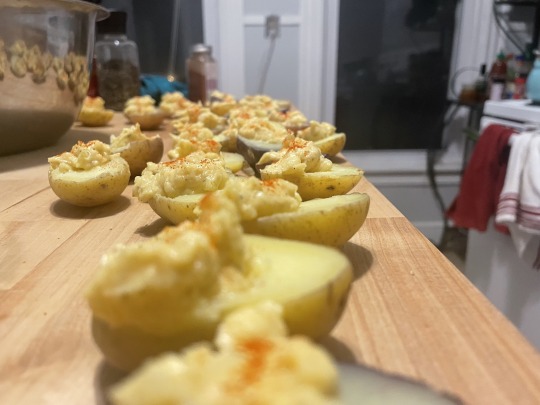
I'm being very genuine when I say that my mom's partner has told me that this is his favorite thing, and he needs me to bring it to every family gathering we go to.
#vegan#food#cooking#deviled potatoes#plant based#vegan food#home cooking#vegetarian#recipe#finger food
0 notes